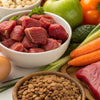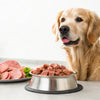How to Introduce Raw Food to Your Dog: A Comprehensive Guide for Pet Owners
- Houndsy
Table of Contents
- Introduction
- Understanding the Raw Food Movement
- Essential Nutrients in a Raw Diet
- Transitioning to a Raw Food Diet
- The Benefits of a Raw Food Diet for Dogs
- The Risks of a Raw Food Diet for Dogs
- Is a Raw Diet Right for Your Dog?
- Should You Mix Kibble and Raw?
- Conclusion
Introduction
Imagine your dog, wagging its tail excitedly as you prepare a meal that not only looks appetizing but is also tailored to meet their nutritional needs. Catering to our furry companions in this way has surged in popularity, leading many pet owners to consider a raw food diet. Research suggests that an estimated 15-25% of dogs now incorporate raw meat into their diets, reflecting a growing trust in this natural feeding philosophy. However, ensuring a safe and balanced transition to raw food requires careful planning and understanding.
In this blog post, we’ll guide you on how to introduce raw food to your dog effectively and safely. By the end, you’ll have a clear roadmap for integrating this dietary shift, ensuring your dog receives a nutritionally balanced raw diet while minimizing potential risks. We’ll explore the foundational concepts of raw feeding, the nutritional components required for a complete diet, steps for an effective transition, and considerations regarding your dog’s unique needs.
So, whether you’re a seasoned pet parent or new to raw feeding, let’s reflect on your dog’s current feeding routine and how to enhance it for better health and vitality.
Understanding the Raw Food Movement
What is a Raw Food Diet for Dogs?
The raw food diet, sometimes known as the Biologically Appropriate Raw Food (BARF) diet, originated in the 1980s and emphasizes feeding dogs a diet akin to what their ancestors would have consumed in the wild. This means prioritizing raw meats, bones, organs, and even some fruits and vegetables.
At its core, a raw food diet aims to mimic the natural ancestral diet, believing that our dogs thrive on a nutrient-rich, minimally processed diet that promotes optimal health. Numerous advantages have been attributed to this dietary approach—healthier coats, improved digestion, and even increased energy levels.
Types of Raw Diets
Before we delve deeper into the transition process, it’s essential to understand the different types of raw diets available:
- BARF Diet: This diet emphasizes the completeness and balance of raw meats, bones, and organs, often including vegetables and fruits to provide essential nutrients.
- Raw Meat-Based Diet (RMBD): This model focuses solely on animal-based ingredients, consisting of raw organs, muscle meat, and bones, excluding plant matter.
- Pre-packaged Raw Meals: For those wary of meal preparation, many brands now offer complete raw diets that have been pre-formulated by expert nutritionists.
Understanding which type suits your dog best will significantly enhance the transition experience.
Essential Nutrients in a Raw Diet
To ensure your dog thrives on a raw diet, understanding its nutritional components is crucial:
1. Muscle Meat
The primary source of protein, muscle meat, provides essential amino acids crucial for your dog’s overall energy and vitality. Incorporating different protein sources, such as chicken, beef, and fish, ensures a diverse amino acid profile.
2. Organs
Next, we have organ meats—think liver, heart, and kidneys. These are packed with vital vitamins and minerals, providing essential nutrients that might be missing from an all-muscle meat diet.
3. Bones
Raw, edible bones are another significant component—primarily for calcium and other minerals. They also serve to clean your dog’s teeth naturally when chewed. It’s critical to avoid cooked bones, as they can splinter and pose a choking hazard.
4. Fruits and Vegetables
Incorporating certain fruits and vegetables can provide additional fiber, vitamins, and antioxidants. Dog-safe options like blueberries, carrots, and pumpkin can help support digestion and overall health.
5. Supplements
While a well-formulated raw diet can be quite complete, certain supplements may still be necessary to cover any nutritional gaps. Fish oil, kelp, and even powdered eggshells can enhance their diet.
Balancing Your Dog's Raw Food Diet
Creating a truly balanced raw food diet can be challenging but achievable with diligence. A balanced diet generally consists of around 70% muscle meat, 10% raw meaty bones, and 20% organs, with an addition of fruit and vegetables. Managing these proportions will be essential to avoid imbalances or deficiencies.
Transitioning to a Raw Food Diet
Transitioning your dog to a raw food diet isn’t instantaneous; it’s a journey that requires patience and observation.
Step 1: Start Slow
Begin the transition by gradually introducing raw food into your dog's existing diet. Start with a small portion of raw food, mixing it in with their current kibble or cooked food. Over a week or two, increase the raw portion while decreasing the old food.
Step 2: Monitor for Changes
Throughout this transition, closely monitor your dog for any changes in stool, energy levels, or digestion. Some dogs may experience soft stools or mild tummy upset initially, which should stabilize over time as their digestive system adapts.
Step 3: Variety is Key
Once your dog is fully switched to a raw diet, it’s essential to introduce a variety of protein sources gradually. This can help ensure they receive a wide array of nutrients and prevent dietary boredom.
Step 4: Consult Your Veterinarian
As with any dietary change, consulting your veterinarian is wise, especially if your dog has existing health conditions or specific dietary needs. They can help guide you in creating a balanced diet and monitor your dog's transition.
The Benefits of a Raw Food Diet for Dogs
While every diet has its pros and cons, many pet owners report that their dogs enjoy a multitude of benefits from a raw food diet.
Shinier Coats and Healthier Skin
A diet rich in omega-3 fatty acids from sources like fish can lead to healthier skin and a shiny coat. Many pet owners notice that their dogs’ fur becomes glossier and sheds less on a raw diet.
Stronger Teeth and Fresher Breath
The natural chewing of raw bones helps to reduce plaque buildup, promoting dental health and fresher breath. Say goodbye to costly dental cleanings!
Better Digestion and Smaller Poops
Raw food is typically more digestible for dogs than processed kibble, which may lead to smaller and firmer stools—a bonus for every dog owner.
Increased Energy Levels
Many transitioners report that their dogs become more energetic and vibrant after switching to a raw food diet, finding that their pups are more playful and agile.
Weight Management
With raw foods being less processed and filled with fillers, they provide a more natural source of nutrition, which may help in maintaining a healthy weight.
The Risks of a Raw Food Diet for Dogs
While the advantages are appealing, it’s crucial to address the potential risks involved with feeding your dog a raw diet.
Bacterial Contamination
Handling raw meat involves dealing with bacteria such as Salmonella and E. coli. Care must be taken to store food properly, clean surfaces, and wash hands after preparing meals to avoid cross-contamination.
Nutritional Imbalance
Improperly balanced raw diets can lead to nutritional deficiencies or toxicities. It’s essential to adhere to the recommended proportions of muscle meat, organs, and bones to maintain good health.
Bone Safety
While raw bones can provide dental benefits, safety is paramount. Special attention must be paid to the size and hardness of bones to prevent choking or injury. Always supervise your dog when feeding them raw meaty bones.
Parasites
Unfrozen or poorly sourced raw meat may contain parasites. Always purchase from reputable suppliers and freeze meat to mitigate risks.
Is a Raw Diet Right for Your Dog?
While many dogs thrive on raw diets, it's important to evaluate whether it suits your dog's unique circumstances:
Best Suited For:
- Healthy, Active Dogs: Dogs with a high energy level often excel on raw diets due to their protein needs.
- Dogs with Allergies: A raw diet can help to bypass common allergens found in commercial kibble.
- Weight Management: Raw diets are generally leaner and can assist in maintaining a healthy weight.
When to Be Cautious:
- Puppies and Seniors: Young or aging dogs may have unique nutritional requirements, necessitating more specialized diets.
- Health Issues: Dogs dealing with specific health conditions should consult a veterinarian to determine if a raw diet is appropriate.
Should You Mix Kibble and Raw?
Combining raw food with kibble can be advantageous for many owners, allowing variety and tailored nutrition. This mixed feeding approach can provide balanced nutrition while alleviating the pressure of an all-raw diet. However, caution should be exercised to prevent digestive upset. Consulting a veterinarian for personalized advice can ensure that your dog continues thriving.
Conclusion
The choice to introduce a raw food diet for your dog can be an empowering one, but it requires diligence and awareness. By understanding the essentials of raw feeding, being cautious about the potential pitfalls, and ensuring a balanced and gradual transition, we can significantly enhance our dogs' health and well-being.
Are we ready to explore how the Houndsy Kibble Dispenser could help you maintain consistency and ease in your dog's feeding routine? The blend of innovative design and function—perfect for pet parents who want the best for their furry companions—is just a click away. Explore the Houndsy Kibble Dispenser now.
FAQ
1. What is the BARF diet and how does it differ from RMBD?
The BARF diet and RMBD both advocate for raw feeding; the BARF diet includes a variety of raw meats, bones, and vegetables, while the RMBD focuses exclusively on animal ingredients.
2. How can I ensure my dog is getting a balanced raw diet?
Consulting a veterinarian or a pet nutrition expert can help create a balanced diet tailored to your dog’s specific needs, including incorporating all necessary nutrients from various sources.
3. What are the signs that my dog is not adjusting well to a raw diet?
Signs of a poor adjustment may include persistent diarrhea, vomiting, lethargy, and refusal to eat. If such symptoms occur, consult your veterinarian for guidance.
4. Can I make my own raw dog food?
Yes, many pet owners successfully prepare raw dog food at home. However, it’s important to understand how to balance the diet properly and ensure food safety to prevent contamination.
5. What are the potential risks of a raw food diet?
Potential risks include bacterial contamination, nutritional imbalances, bone hazards, and potential parasites. Handling raw food properly and consulting a vet can mitigate many of these risks.
Incorporating thoughtful planning, reflection, and thorough research into your dog’s diet can pave the way for a healthier, happier life for you both. Let’s embark on this journey together!












